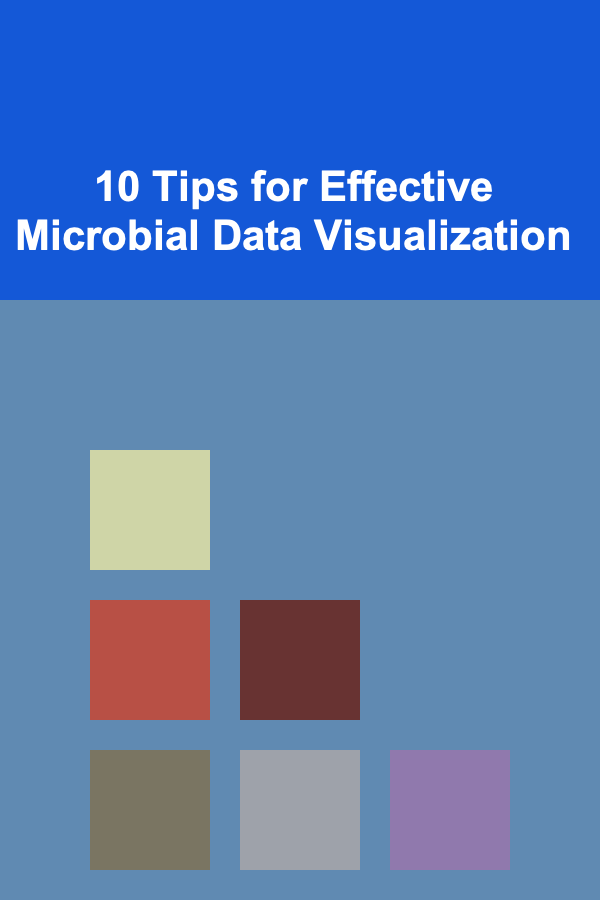
10 Tips for Effective Microbial Data Visualization
ebook include PDF & Audio bundle (Micro Guide)
$12.99$7.99
Limited Time Offer! Order within the next:

Microbial data, encompassing information on bacteria, fungi, viruses, and other microorganisms, has become increasingly important in various fields, including environmental science, agriculture, medicine, and industrial applications. These complex datasets often contain high-dimensional information, such as genetic sequences, abundance profiles, and ecological interactions. To make this data accessible and actionable, effective data visualization is essential.
Effective microbial data visualization allows scientists and researchers to convey complex information in a clear and comprehensible manner. It also provides insights into the hidden relationships within the data, aiding in decision-making processes and hypothesis generation. In this article, we will explore ten key tips for creating effective microbial data visualizations that not only convey the necessary information but also engage the audience and provide actionable insights.
Understand the Purpose of Your Visualization
Before diving into creating any visualization, it is critical to understand the purpose of the data visualization. Different types of data serve different functions and require specific visual approaches. For microbial data, the objectives might include:
- Descriptive Visualization: Showing basic patterns or trends in microbial communities or abundance across different conditions.
- Comparative Visualization: Comparing microbial communities between different environments or experimental conditions.
- Correlative Visualization: Identifying relationships between various microbial species or between microbial species and environmental variables.
- Predictive Visualization: Modeling and predicting future microbial behaviors or trends.
Understanding the purpose helps guide which elements and visual strategies to use. For example, if your goal is to show microbial diversity across various environments, a diversity index chart or heatmap might be appropriate. For a comparative analysis, bar plots or side-by-side box plots could be more effective.
Choose the Right Visualization Type
Selecting the appropriate visualization type for microbial data is crucial to presenting the right message. Different visualization methods emphasize different aspects of data. Here are some commonly used types for microbial data:
2.1 Heatmaps
Heatmaps are one of the most common visualization techniques used for microbial data. They allow for the display of large datasets with a color gradient, where the colors represent different values or intensities. Heatmaps are excellent for showing abundance levels of microbial species across multiple samples, revealing patterns and trends.
2.2 Principal Coordinate Analysis (PCA)
Principal Coordinate Analysis (PCA) is often used to reduce the dimensionality of large microbial datasets. PCA plots show the distribution of samples in a lower-dimensional space, with axes representing the largest sources of variation. PCA is useful for exploring the overall structure of microbial communities and for identifying groups of samples with similar microbial profiles.
2.3 Bar Charts and Stacked Bar Plots
Bar charts are simple yet powerful for visualizing microbial abundance or species diversity. Stacked bar plots, which break down the total abundance of a sample by microbial species, are particularly useful for comparing the relative composition of microbial communities across multiple conditions.
2.4 Network Diagrams
Network diagrams can help visualize interactions between microbial species, such as co-occurrence or competition. These visualizations are especially useful for illustrating complex ecological interactions or the structure of microbial communities.
2.5 Circular Visualizations
Circular visualizations, such as circos plots, allow for the display of large datasets with multiple dimensions, such as species abundance, diversity, and co-occurrence patterns. These plots are highly effective for showing hierarchical relationships or connections in microbial datasets.
2.6 Phylogenetic Trees
Phylogenetic trees are used to represent evolutionary relationships among microbial species. These tree-like structures allow for an intuitive understanding of how different microbes are related and are often employed in genomics to display sequence similarities.
Simplify Complex Data
Microbial datasets often involve large amounts of data, with hundreds or thousands of microbial species, genes, or samples. It is essential to simplify this data to make it interpretable. Here are some techniques to achieve this:
- Focus on Key Variables: Instead of showing every microbial species, focus on a subset of species or variables that are most relevant to your research question.
- Reduce the Dimensionality: Use methods like PCA or t-SNE to reduce the number of dimensions in your data, making the visualization more manageable and highlighting the most significant trends.
- Summarize Data: Use summary statistics such as mean, median, or standard deviation to represent large datasets with a few key metrics rather than raw data points.
Use Color Wisely
Color is one of the most powerful tools in data visualization, but it must be used judiciously. The wrong color scheme can confuse or mislead the audience. Here are some best practices for using color in microbial data visualizations:
4.1 Use a Colorblind-Friendly Palette
Approximately 8% of men and 0.5% of women experience color blindness. To ensure that your visualization is accessible to all viewers, choose color schemes that are colorblind-friendly. There are several online tools, such as Color Brewer, that provide palettes specifically designed for accessibility.
4.2 Avoid Overuse of Color
While color can highlight important data points or trends, overusing color can make the visualization chaotic and hard to interpret. Use color strategically to differentiate between key categories or highlight important patterns.
4.3 Choose Color Gradients Carefully
For continuous data, such as abundance levels, use color gradients that have a clear, logical progression. Avoid using too many colors in the gradient, and ensure that the gradient represents the data accurately (e.g., a gradient from light to dark to represent low to high values).
Ensure Data Consistency
Consistency in data presentation is key to helping the viewer understand your visualization. Ensure that the same data is represented in a uniform way across all your visualizations. Here are some things to keep in mind:
- Axis Labels and Units: Be consistent with the labeling of axes and units across different visualizations to avoid confusion.
- Legend and Color Codes: If you're using color to differentiate between categories, include a legend that clearly defines what each color represents. Always ensure that the same categories are represented consistently in all visualizations.
- Data Normalization: When comparing different microbial communities, it's often necessary to normalize the data (e.g., through relative abundance) to account for differences in sample size or sequencing depth.
Interactive Visualizations
Interactive visualizations allow users to explore microbial data on their own, making them particularly useful for large datasets. By providing interactivity, you can allow users to zoom in on specific areas, filter data based on different parameters, and explore relationships within the data more deeply.
6.1 Zoom and Filter Features
For large datasets, interactive visualizations with zoom-in capabilities and filters enable users to drill down into specific data points of interest. This makes the visualization more engaging and interactive.
6.2 Hover for Details
Include hover-over functionalities that display additional information when users move their cursor over specific data points. This allows the audience to access detailed information without cluttering the main visualization.
6.3 Dynamic Updates
For time-series data or sequential microbial data, consider using dynamic or animated visualizations that allow the viewer to see changes over time.
Label Data Clearly
One of the biggest challenges in microbial data visualization is ensuring that the data is easy to interpret. This can be achieved by using clear, concise labels and annotations that provide context and meaning. Labels should include:
- Clear Titles and Descriptions: Every graph or chart should have a clear, descriptive title that explains what is being visualized.
- Axis Labels: Make sure that the axes are clearly labeled with both the variable name and units.
- Annotations: Add annotations to highlight important data points, trends, or outliers. Annotations can also be used to explain unexpected patterns or provide additional context.
Ensure Scalability and Compatibility
Microbial data visualizations should be scalable to handle large datasets, and they should also be compatible with various platforms and devices. This is especially important when dealing with big data in microbial ecology, genomics, or metagenomics.
8.1 Scalability
Ensure that your visualization tool can handle datasets of varying sizes. If you're working with massive microbial datasets, consider using specialized software like R, Python (e.g., Matplotlib, Seaborn), or visualization platforms like Tableau or D3.js that are optimized for scalability.
8.2 Compatibility
Make sure that the visualizations are compatible with different devices and browsers. Mobile-friendly visualizations are particularly important if your work will be shared with a broad audience.
Validate Your Visualization
Once your microbial data visualization is complete, it is important to validate it for accuracy and usability. This involves:
- Double-Checking Data: Ensure that the data used in the visualization is accurate and has been processed correctly.
- User Testing: Show your visualizations to colleagues or other stakeholders and gather feedback. They may identify areas for improvement or potential misunderstandings.
- Cross-Check with Other Visualizations: Compare your visualizations with others in the field to ensure consistency and alignment with best practices.
Keep the Audience in Mind
Finally, always keep the audience in mind when designing microbial data visualizations. Understand who will be viewing the visualization and what they need to understand from it. If your audience includes non-experts, simplify the data and avoid using highly technical jargon. On the other hand, if your audience consists of fellow researchers, you can use more complex and detailed visualizations.
Conclusion
Creating effective microbial data visualizations is both an art and a science. By following these ten tips, you can craft visualizations that not only present complex data clearly and accurately but also engage and inform your audience. The goal of any microbial data visualization is to make the data accessible and actionable, whether you are exploring microbial diversity, ecological interactions, or genomic patterns. The right visualization can turn raw data into insights, guiding research decisions and advancing our understanding of microbial ecosystems.
Reading More From Our Other Websites
- [Personal Investment 101] Investing in Deep Learning Projects to Generate Long-Term Passive Income
- [Personal Financial Planning 101] How to Understand and Manage Your Credit Card Debt
- [Home Storage Solution 101] How to Choose the Right Storage Bins for Every Room
- [Survival Kit 101] Essential Survival Tools for a Bug Out Bag: Must-Have Gear for Emergency Evacuations
- [Personal Financial Planning 101] How to Manage Your Finances as a Freelancer or Entrepreneur
- [Home Budget Decorating 101] How to Repurpose Old Furniture for Stylish New Pieces
- [Personal Investment 101] How to Choose the Best Investment Strategy for Your Risk Profile
- [Home Rental Property 101] How to Draft Water-Tight Rentals with Flexible Lease Terms Agreements
- [Biking 101] Top 5 Bike Pedals for Comfort and Performance
- [Star Gazing Tip 101] Night Sky Meditations: Transformative Lessons from the Stars for Modern Living

Creative and Cost-Effective DIY Home Improvement Projects for Beginners
Read More
How to Check and Maintain Your Home's Sewer System
Read More
How to Cut Costs on Cleaning Supplies and Household Products
Read More
How to Decorate Your Home for a Chic Dinner Party
Read More
How to Find the Best Affordable Options for Home Insurance: An Actionable Guide
Read More
How to Advocate for Renewable Energy Transition
Read MoreOther Products

Creative and Cost-Effective DIY Home Improvement Projects for Beginners
Read More
How to Check and Maintain Your Home's Sewer System
Read More
How to Cut Costs on Cleaning Supplies and Household Products
Read More
How to Decorate Your Home for a Chic Dinner Party
Read More
How to Find the Best Affordable Options for Home Insurance: An Actionable Guide
Read More